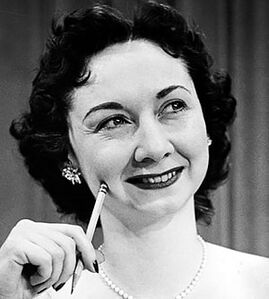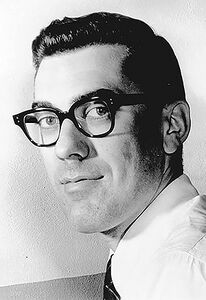What Do I Do?
| What Do I Do? | |
|---|---|
| Genre | Game show |
| Starring |
|
| Country of origin | Gylias |
| Original language(s) | |
| No. of episodes | 915 |
| Release | |
| Original network | GTV1 |
| Original release | 1 February 1959 – 5 September 1976 |
What Do I Do? is a Gylian panel show. It originally aired on Sundays from 1 February 1959 to 5 September 1976, on GTV1.
Known for its distinctive atmosphere and gameplay, it became a notable success of the 1960s–1970s, mainly appealing to an older audience during the Golden Revolution era. It remains one of Gylias' best-known game shows.
History
Estelle Parker, Head of Programming at GTV alongside her sister Cecilia, asked for staff to conceive a show that would appeal to an older audience. In later interviews, she described it as a counterpart to shows like Outer View and Ready Steady Go!, and said her motivation was "to make sure we didn't leave older viewers out in the cold, like if you're past the age of 30 you don't exist."
The final idea GTV settled on was a game show, where celebrity panelists would question contestants to guess their occupation. A working title was Who Am I?, which was changed after one producer complained that it reduced people to their occupations.
What Do I Do? began airing on 1 February 1959. It became a modest success. Although the show never reached the heights of Ready Steady Go! or Agent Jane, it was a stalwart of the GTV1 line-up, being the penultimate program to air on Sundays, before Þeo Þorman's weather report and sign-off. It was known for the quality of its guests, both already-known and who would later gain fame.
GTV licensed the show for broadcast abroad, giving it greater exposure during the Gylian Invasion. It resulted in several foreign versions.
The show ended on 5 September 1976, due to the death of panelist Doortje Koelewijn. GTV chose to end production rather than try to replace her.
Its episodes were made available on Proton in the 1990s.
Production
What Do I Do? was filmed in one of GTV's Mişeyáke studios. It was a low-budget production: Estelle Parker joked that the entire set was "one table, four chairs, and a blackboard." It was filmed live before a studio audience.
The show had no host. Indeed, finding a host to complement the panel had been a stumbling block for GTV. Jane Ace was offered the job, but she declined, telling the producers it would turn the show into another Easy Aces. Doortje joked that "in the end GTV gave up and just threw us out in front of cameras with a mandate to fill up half an hour somehow."
To compensate for the lack of host, the panel adopted the technique of walking on stage one by one and introducing themselves.
Game play
The show was a guessing game, in which the four panelists tried to guess the occupation of a guest. There were two kinds of rounds: a standard round, and a mystery guest round.
In the standard round, the guest walked in, wrote their name on a blackboard, and met the panel up close for a casual inspection. They would be asked where they lived and how they wanted to be addressed. The guest told the rest of the crew their occupation, which one of the crew members would reveal to the studio and home audiences with a cue card.
The panel could only ask yes or no questions. If the answer was yes, the panelist continued questioning. If the answer was no, the next panelist took their turn, and the contestant won Ŧ50. The contestant won the top prize of Ŧ500 for 10 negative answers. The low value of the prize ensured the game was played only for enjoyment, and sometimes prompted humorous comments from winners.
Panelists could pass to the next panelist, disqualify themselves entirely if they somehow knew the answer, or conference among themselves and openly discuss ideas about occupations and questions. They would often phrase questions in the negative to increase the probability of affirmative answers.
The mystery guest round involved blindfolding the panel and challenging them to identify a celebrity guest by name. Mystery guests came from all walks of life — the arts, sports, politics, or academia. They usually tried to disguise their voices, much to the amusement of the studio audience. When the panel guessed the identities early on, they would let questioning pass around at least once before guessing correctly, to let audiences see the guest play the game.
A typical episode had 2–3 standard rounds and a mystery guest round, which was last or second-to-last. After the end of a round, the panel encouraged contestants to demonstrate their talents.
Besides the game winnings, contestants were paid Ŧ5000 as an appearance fee, regardless of whether they won or lost, and the show covered the expenses for their travel to Mişeyáke.
Panel
The show featured a panel of four notables who questioned contestants. They were:
Doortje Koelewijn
(a journalist known for "The Talk of the Town")Arlène François
(an actress and radio host)Ler Siréy
(a sportswriter)Goodman Ace
(a humourist best known for Easy Aces)
The rapport of the panel was essential to the show, and the panelists trading bon mots with themselves and contestants was the main attraction for many viewers. Denise Sarrault described their dynamic:
"Arlène exuded unfeigned warmth, while Doortje had the go-for-the-jugular impulse of a gossip columnist. Goodman lost none of the low-key charm that had made Easy Aces a beloved radio serial, while Ler had an odd-one-out quality that rounded out the panel nicely."
Many running jokes emerged out of the panelists' good-natured teasing. Doortje's Dutch accent was often the butt of jokes for its "gargled" quality, and her colleagues would gleefully butcher her full name. Ler was subject to attempts to "one-up" him by the others inventing fictional sports and sportspersons to fool him into thinking they knew more. The panelists talked among themselves and with guests in English and French, but occasionally made quips in their native languages — Doortje in Dutch, Arlène in Hayeren, and Ler in Erlan.
Another source of humour was the contrast between the panelists' attention to manners and the simple surroundings. With no host and a minimal crew, the game was self-moderated. Doortje humorously assumed the role of "ambiance guardian". She usually spoke first while inspecting contestants, setting the appropriate tone, and her notion of decorum was mainly concerned with courtesy towards guests and avoiding insulting barbs. Her colleagues poked fun at her role by trying to slip double entendres past her, causing her to laugh.
Gylias Review wrote in 1999 that the show's success came from its "innocent" character:
"The genial bonhomie and good-natured repartee of What Do I Do? gave viewers the impression they were invited to a charming salon, which happened to gather the finest of Gylias' arts and public life for a fun party game. The hosts themselves were clearly well-read, conversant with the arts and on top of current events. It was easy to imagine the panelists and guests all knew and liked one another, and probably went over to Sibylla for a drink afterward."
Reflecting the show's image, the panelists sometimes made jokes about their supposed ignorance of contemporary pop culture. In a 1963 episode, Doortje asked, "Ah, yes, the Beaties — who are they?", to which Ler replied, "They're a popular beat combo". The phrase "popular beat combo" became popular afterwards, often self-applied jokingly to suggest an act was primarily pop-oriented and not interested in "heaviness".
Guests
The show's producers alternated between selecting contestants with ordinary and unusual occupations, and sought to represent all of Gylias' regions and ethnolinguistic groups.
Several future famous Gylians appeared on the show when they were just starting out, including Sara Thomas, Brigitte Nyman, Mana Kirishima, Liisa Salmela, Alike Demetriou, Meiko Kaji, Rauna Næsve, and Victoria Douglas. Future Allamunnic prime minister Eleanor Henderson appeared twice, once as a contestant and the second time as a mystery guest.
The show also used the mystery guest slot to acknowledge esteemed figures from Alscia and the Free Territories, such as Cécile Sorel, Niní Marshall, Reda Kazan, Olivia Dafi, the Gish sisters, surviving members of the honoured citizens list, and members of the fine arts salon in the Senate. Dæse Şyna's appearance is considered a highlight of the show.
One notable mystery guest was Sofia Westergaard, former Chancellor of Delkora and then Delkoran ambassador to Gylias. During a state visit by Mette Elvensar, her secretary Glykera Damonides appeared as a contestant.
Legacy
What Do I Do? achieved a pop cultural impact that belied its modest success or low-budget presentation. It became an "esteemed institution" of GTV, symbolically ending the week in its timeslot on Sunday evening. The urbane character of its panelists and wit gained it popularity beyond its target audience of older viewers. Rasa Ḑeşéy's documentary Nation Building features interviews with several Gylians who observed that in their youth, they bonded with older family members or acquaintances by watching the show together.
Through its classy atmosphere and distinguished guests, the show represented socialised luxury and aristerokratia on screen. It provided viewers with examples of sympathetic adult figures at ease with the changes sweeping Gylias, thus fulfilling its mission of preventing older audiences' alienation. Doortje's tongue-in-cheek insistence on good manners earned her the reputation of an elegantly old-fashioned conservative like Isabel Longstowe, although ironically she wrote for the social democratic The Republic.
Although seen as counterparts, Ready Steady Go! presenter Cathy French commented that the two shows were more alike than their reputation suggested: "What Do I Do? is just as anarchic as us, just quieter. They don't have a director, they don't have a host, they have less of a crew than us, they do everything live, and they're basically left to fend for themselves before the audience and cameras." The two shows enjoyed a good relationship; Arlène occasionally invoked RSG!'s catchphrase "The weekend starts here!" and closed the show with "The weekend ends here. Bonne nuit, mes chéries."
The show found unexpected popularity in Delkora, and spawned a Delkoran version produced by DBS. Nora Gunnarsen analysed the show's appeal to Delkorans:
"For a country riven by class conflict and just emerging from the 1950s depression, What Do I Do? seemed like a transmission from an alien planet: it was low-key but sophisticated, decorous without being staid, like a Jaerevik clique dream come true. None of the panelists were conventionally graceful — Doortje used the English language as mouthwash, Ler seemed to know nothing but sports — but it was clear from how they talked and carried themselves whose side they were on, and it sure wasn't the rich or the nobility."



